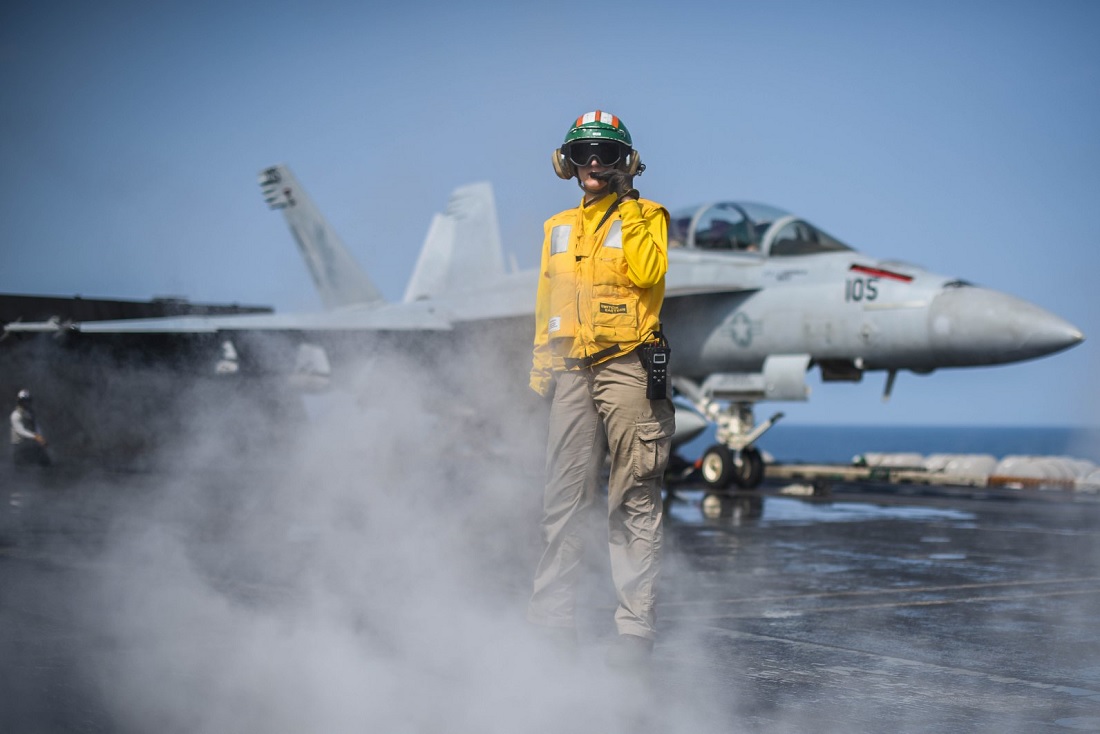The 35 women made history by launching 35 aircraft from the flight deck of USS Theodore Roosevelt on the last day of February in the Persian Gulf
On Feb. 28 this year, a launch crew comprising mostly of women took over the job of launching aircraft from the flight deck of USS Theodore Roosevelt (CVN 71).
The 35 women made history by launching 35 aircraft on the last day of February in the Persian Gulf. According to The San Diego Union-Tribune, that was the first time in the ship’s 32-year history that a launch crew was mostly women.
It was a small moment in a seven-month tour that saw the USS Theodore Roosevelt travel more than 56,000 miles and fly 1,164 combat sorties over Syria, Iraq, and Afghanistan, but one pilot thinks it still important.
“I’m kind of speechless about it, honestly,” said Lt. Elizabeth “Lana” Grider, an MH-60S Seahawk helicopter pilot.
Grider, who returned to North Island on May 7, 2018, served as a yellow-clad “shooter” on the deployment. Shooters are the supervisors who make sure every sailor is safely positioned before they greenlight a steam catapult to hurl a jet into the air.
“I’m extremely proud of this team. This started at the deck plate level, not the officers,” she said. “They wanted to do this for themselves and take this unique opportunity to launch aircraft with an all-female launch crew, which doesn’t happen too often.”
Aviation Boatswain Mate 2nd Class Esperanza Romero was the one hitting the “fire” button to fling the jets.

“It all comes down to teamwork,” said Romero, of Denver, a supervisor on a mixed male and female team operating the carrier’s bow catapult. “Men and women work together. Yes, aviation boatswain mate’s pretty much a male-dominated rating but more women are going into it and we wanted to show what we can do.
“For this event, we couldn’t have accomplished it without the hard work and dedication of all our junior sailors. The job we do is strenuous and rough and not everyone wants to do it, but they’re proud to do it.”
Aviation Boatswain Mate 3rd Class Teneshia Walton spent the morning feeding data about the planes to the rest of the crew and operating the blast deflector, the steel fence that redirects blowtorch-hot air and debris churned up from jet engines away from sailors and other aircraft.
That job can get even more dangerous when sailors are toiling on rain-swept decks battered by winds, but she loves it.
“It can involve a lot of long hours doing hands-on work but I’m always really excited to get things working, to get it all rolling,” said Walton, of St Louis. “It’s not an easy job but you come to appreciate what you do and those you work with.
“No one person can do all of this. Everyone has a role to play and we work together to do it.”
Although shooter Grider said that the female crews joined together on Feb. 28 to prove something to themselves — not the U.S. Navy or the country — news about the launches began to ripple far beyond the Persian Gulf, spread by social media.
“My hope is that a young woman or a young girl might see this story and be inspired to work on a flight deck, too,” Grider said. “You can do this. We proved that.”
Photo by Mass Communication Specialist 3rd Class Alex Corona / U.S. Navy

